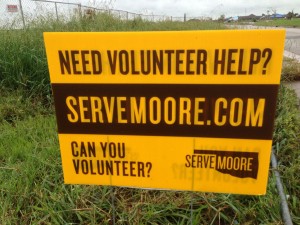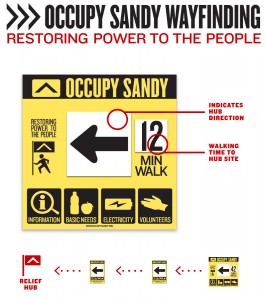In May of 2013, Oklahomans in the area around Moore and Oklahoma City were hit by two strings of devastating tornados. In Moore in particular, one could see the swath of total destruction carved through the city and across the interstate highway. Schools, shopping areas, and entire neighborhoods were totally destroyed. After the initial shock, people immediately asked, “how do we rebuild our lives and our community?” Government organizations leapt into action to assist in rescue operations, provide emergency medical services, and coordinate assistance. Alongside these public agencies were many nongovernmental, community organizations that offered services ranging from debris removal to shelters for people who had lost their homes.
After tornados devastated Moore, in short, the whole community, not only public officials, stepped up to propel the rebuilding process. For disasters to come in many other places, my research explores how community organizations, including those new to emergency management, can similarly support efforts to respond and rebuild.
The Resilience of Communities
The first step in building resilient communities is to take stock of the range of human and organizational resources. Emergency officials have a long history of looking outside their own offices for support. The Federal Emergency Management Agency, for example, has only a relatively small work force of its own, and thus routinely relies on supportive local partners.
- Local American Red Cross offices help to manage shelters.
- Local emergency organizations conduct rescue operations.
- Other organizations, including private companies as well as nonprofits, deliver supplies.
Similarly, during disasters local emergency management offices rely on fire and police offices for personnel to provide security and conduct operations in affected neighborhoods. Dealing with disasters has always involved orchestrating the efforts of many actors who lend and combine diverse strengths to build a resilient community.

The only new development is the breadth of the collaborative network, as new organizations regularly step up. After Hurricane Katrina hit New Orleans, housing charities, work training organizations, and many other groups volunteered to help. After “Super Storm Sandy” on the East coast, disability advocacy groups pitched in to help many affected people. Lately, the Society for the Prevention of Cruelty to Animals has begun to work with communities on how to handle pets during disasters and evacuations. In short, while extreme events such as the Moore tornadoes and the Katrina and Sandy storms have revealed the vulnerabilities in affected communities, they have also revealed new sources of strength and resilience – teaching lessons that can carry over into other community responses to disasters.
Community organizations possess unique resources and expertise that are difficult or impossible to replicate within the government. Particularly in an era of budget cutting, government organizations could not replace the national network of shelters run by the American Red Cross; nor could governments maintain case management systems to direct people affected by disasters to the various resources available to them. When disasters strike, officials must know they can reach out to community organizations to provide the full array of services residents need.
It Takes Planning and Practice to Include Civic Organizations
But recognizing diverse resources within the community is only the first step. The second, and harder, step is to include these organizations in planning, building trust and familiarity in advance of emergencies. Traditionally, emergency management networks have been knit together during years of interaction, planning, and training. This strategy has worked, but it remains challenging to integrate new organizational partners into long-term networks.
Emergency managers need to know that new participants are reliable and will not falter or fade after the worst of a disaster is past. At times, volunteers have failed to show up when called upon and many don’t return after the first day of an emergency. This experience can leave emergency managers worried about how reliable groups might be in disaster response and recovery – especially new groups that have not built up experience and a solid reputation already.What is more, new participants need to know that their contributions will be valued and respected. Organizations aiming to contribute usually understand that they play a supportive role in disaster planning, yet their leaders and core volunteers need to feel trusted and know that their expertise is respected. Emergency managers therefore must engage with potential volunteer organizations to build trust over time. Frequent interactions, exercises, and training are the keys to including new organizations in disaster response planning. Such a process well in advance of any crisis shows emergency managers that new organizations are here to stay and worthy of their trust, even as it also helps the organizations feel comfortable and vitally involved. Although it takes time, constructing cooperation in this way builds the trust essential for diverse, resilient community contributions during disasters and reconstruction.

Important institutional mechanisms already exist to foster disaster response networks. National and state emergency management organizations have sought to create and sustain community-based teams for training purposes. Most notably, the Federal Emergency Management Agency created Community Emergency Response Teams teams to educate volunteers within each community about how to prepare for disasters. In part, this involves weaving prior ties between community organizations and disaster agencies, but it also means identifying a few people in each neighborhood with first aid skills and disaster readiness kits at hand.
Across America, efforts such as these have a long way to go to forge strong, pre-positioned networks of organizations and people sufficient to cope when disasters happen. But strides have been made in harnessing the cooperative potential of public agencies and private groups in every U.S. community, preparing them to come quickly together to give needed emergency help during disasters and speed rebuilding in the aftermath.

 Research to Improve Policy: The Scholars Strategy Network seeks to improve public policy and strengthen democracy by organizing scholars working in America's colleges and universities. SSN's founding director is Theda Skocpol, Victor S. Thomas Professor of Government and Sociology at Harvard University.
Research to Improve Policy: The Scholars Strategy Network seeks to improve public policy and strengthen democracy by organizing scholars working in America's colleges and universities. SSN's founding director is Theda Skocpol, Victor S. Thomas Professor of Government and Sociology at Harvard University.